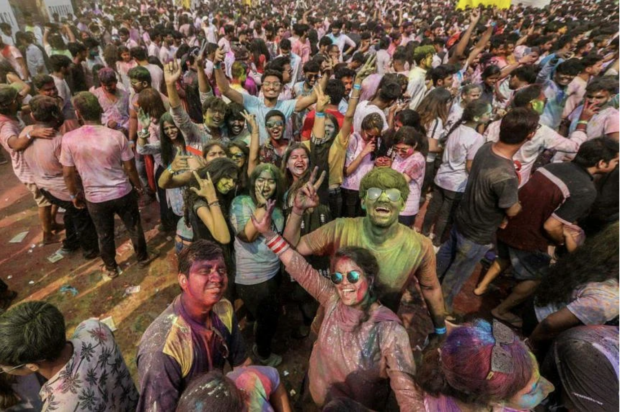Some women shun Holi celebrations in India, fearing violence that can lurk behind innocent fun

Revelers celebrating Holi in Mumbai on March 7. Harassment of women during the Hindu spring festival is a problem in India. PHOTO: EPA-EFE via The Straits Times/Asia News Network
NEW DELHI – Holi each year is an exercise in hiding for 43-year-old Meenakshi Iyer.
She locks herself in her house, sometimes feigning illness, to keep out neighbors who wish to smear colors on her, as is customary during the Hindu spring festival.
At office Holi parties, the freelance illustrator has even holed herself up in the bathroom to steer clear of trouble.
Her dislike stems from when she was about 13 and growing up in Delhi, being targeted by passers-by with balloons filled with what she said was urine and “another gooey substance” that left her with a bad fungal infection.
READ: Outrage in India after video shows woman tourist being groped in Delhi during Holi
“It was really bad,” she told The Straits Times. “Moreover, I don’t like anyone touching me without my consent, pulling my hair or pulling me by my shirt or my hand just to play with them.”
The Noida-based Ms Iyer is one of many Indian women who shun Holi each year because of nightmarish memories of assault and harassment that they have been subjected to over the years – all in the name of the innocent playfulness that is a hallmark of the festival.
Development sector professional Natasha Ramarathnam, 51, also stopped playing Holi more than 3½ decades ago when she was molested by a teenager slightly older than her at a Holi party in Kolkata.
“He grabbed my hand and languidly, very purposefully, applied color on my arms, before pulling my T-shirt and shoving color in while touching my nape,” she said. “Over the years, I realized, this is what happens in classic cases of sexual harassment.”
It is an issue that continues to haunt India, as illustrated by the recent assault on a Japanese female tourist, as well as other videos and reports of Indian women being attacked during Holi festivities and in past years.
Harassment of women during Holi is such a problem that organizers of ticketed Holi parties for the public in India now hire bouncers as a precautionary measure, advertising their presence to reassure visitors.
This year, a girls’ hostel at the University of Delhi prohibited its residents from stepping out before 6pm on the day of the festival. Holi celebrations usually end by dusk.
That this Holi coincided with International Women’s Day was not lost on BharatMatrimony, an online matrimony service.
It posted an advertisement showing a woman washing the colors off her face after playing Holi to reveal bruises. The firm called for celebrations that are “safer and more inclusive” for women.
Some individuals and organizations are fighting back to reclaim Holi from hooligans and make it safe for women to enjoy the festival.
Sahayog, a non-profit organization headquartered in Lucknow, has since 2017 been sensitizing boys and young men on drawing boundaries around consent and respecting women “just as they would their sisters and wives” while playing Holi.
A key phrase reiterated by Holi revelers, ingrained in popular culture, is “Bura Na Mano, Holi Hai” (Don’t mind, it’s Holi). But it can serve as carte blanche for some men to abuse others.
“Everything becomes permissible under this line, whether it is an inappropriate touch or abuse,” said Mr Pravesh Kumar Verma, a team manager with Sahayog.
This year, their campaign, which extended to 48 villages across four districts of Uttar Pradesh, tweaked the phrase to “Bura Na Mano Holi Hai, Par Bura Mano” (Don’t mind, it’s Holi; but do mind…).
“One must get offended and angry if something inappropriate has been said or done,” added Mr Verma.
But Holi can also empower women, especially in smaller towns and rural parts, to come out of what may be cloistered lives and revel in public spaces.
In Barsana, a place in Uttar Pradesh that is believed to be the birthplace of Hindu goddess Radha, the chief consort of Krishna, people play Holi in a unique manner, reminiscent of Krishna’s playful relationship with his female companions.
Women here have the upper hand. Armed not just with colors but with sticks, they “beat” up men from Krishna’s village, Nandgaon, while the latter defend themselves with shields.
The problem, as many point out, is not with Holi but with how some men have turned the festival into a “gropefest”, riding roughshod over female consent.
“I don’t think blaming Holi or boycotting it is going to help,” said Ms Iyer.
“A woman can be molested anywhere, which is why we need to make our society at large more women-friendly, and that’s a long-drawn process that begins at home, with parents teaching their children about consent and to respect girls and women.”
Acknowledging it is only some men who have sullied the festival, Ms Ramarathnam said that the vast majority of men who do not speak up against such acts of harassment perpetuates this problem.
“By looking away, an enabling environment is created for harassment of every kind, not just on Holi, and for the perpetrators to get away.”
The solution, she said, will have to come from silent male bystanders. “Today, the few who assault do it because they know that the chances of others even saying anything to them, them being ostracized or being called out is virtually zero.”
Some men are speaking up.
When the BharatMatrimony ad was criticized by certain sections for being “Hinduphobic”, Mr Iyan Karthikeyan, the editor of YouTurn, a fact-checking website, questioned how it could be labeled as such.
“Sexual harassment during Holi is a real issue… Can anyone deny that no such incidents have happened?” he tweeted.
RELATED STORIES